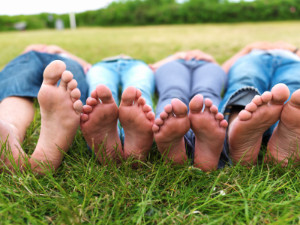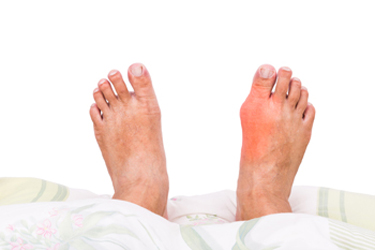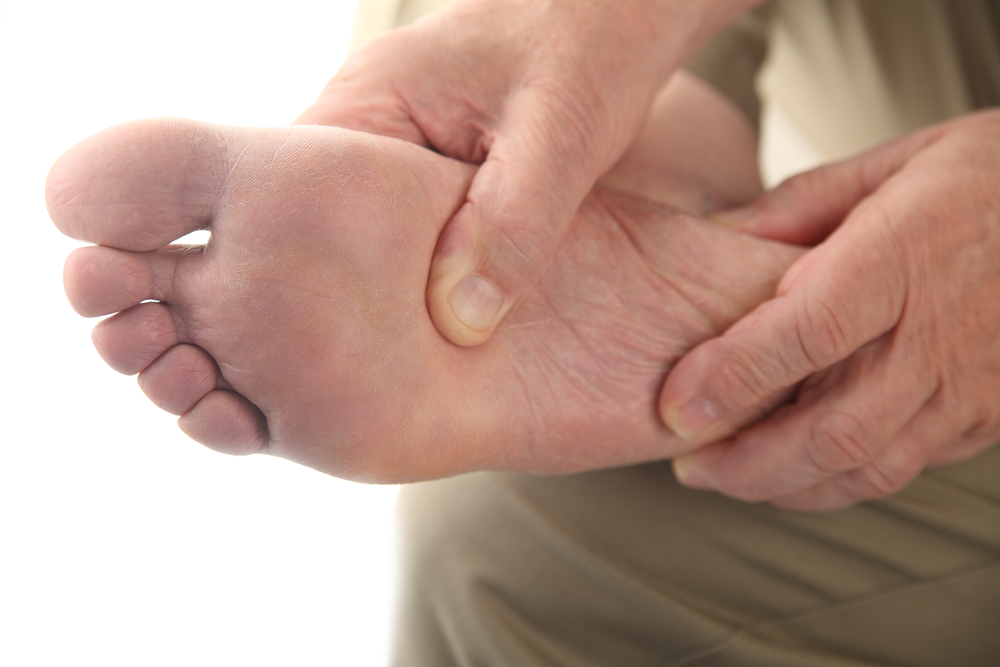Houston
Pearland
 Children’s foot care can often be overlooked by parents. However, keeping your child’s feet healthy can have beneficial long term effects. To help your child in keeping their feet healthy and strong, it’s suggested that you support them when they kick or wiggle their feet, as these motions help to build strength and muscle. It’s also important to refrain from putting restrictive footwear, such as tightly fitted booties, on your child’s feet. Any socks or foot coverings that are worn by the child should be loosely fitted and made of a breathable material. To keep the feet clean, wash and dry your child’s feet thoroughly everyday, making sure to get in between their toes as well. As your child grows, you may want to pay close attention to if their toes turn out a lot, if one foot turns in more than the other, or if by 18 months they’re still not walking at all, in which case you should seek the advice of a professional. For more information about keeping your child’s feet healthy, it’s suggested that you speak with a podiatrist.
Children’s foot care can often be overlooked by parents. However, keeping your child’s feet healthy can have beneficial long term effects. To help your child in keeping their feet healthy and strong, it’s suggested that you support them when they kick or wiggle their feet, as these motions help to build strength and muscle. It’s also important to refrain from putting restrictive footwear, such as tightly fitted booties, on your child’s feet. Any socks or foot coverings that are worn by the child should be loosely fitted and made of a breathable material. To keep the feet clean, wash and dry your child’s feet thoroughly everyday, making sure to get in between their toes as well. As your child grows, you may want to pay close attention to if their toes turn out a lot, if one foot turns in more than the other, or if by 18 months they’re still not walking at all, in which case you should seek the advice of a professional. For more information about keeping your child’s feet healthy, it’s suggested that you speak with a podiatrist.
Making sure that your children maintain good foot health is very important as they grow. If you have any questions, contact Dr. Linda D. Nachmani of Central Foot & Ankle Associates. Our doctor can provide the care you need to keep you pain-free and on your feet.
Keeping Children's Feet Healthy
Having healthy feet during childhood can help prevent medical problems later in life, namely in the back and legs. As children grow, their feet require different types of care. Here are some things to consider...
Although babies do not walk yet, it is still very important to take care of their feet.
Avoid putting tight shoes or socks on his or her feet.
Allow the baby to stretch and kick his or her feet to feel comfortable.
As a toddler, kids are now on the move and begin to develop differently. At this age, toddlers are getting a feel for walking, so don’t be alarmed if your toddler is unsteady or ‘walks funny’.
As your child gets older, it is important to teach them how to take care of their feet.
Show them proper hygiene to prevent infections such as fungus.
Be watchful for any pain or injury.
Have all injuries checked by a doctor as soon as possible.
Comfortable, protective shoes should always be worn, especially at play.
If you have any questions please feel free to contact one of our offices located in Houston, and Pearland, TX. We offer the newest diagnostic and treatment technologies for all your foot and ankle needs.
Read more about What to Do to Keep Your Child’s Feet Healthy Hyperhidrosis is the medical term that is used to define excessive sweating. Some patients have feet that sweat for the majority of the day, and this is referred to as plantar hyperhidrosis. It may happen as a result of anxiety, hormonal changes, or living in a hot environment. This condition may cause embarrassment during the day as the feet begin to slide in certain types of shoes. Additionally, rashes may develop, and there may be an odor coming from the feet. It is beneficial to wear shoes that are made of breathable materials, and comfort may be found when foot powder is frequently sprinkled in the shoes. If you have symptoms of plantar hyperhidrosis, it is strongly suggested that you consult with a podiatrist who can help you to manage this condition.
Hyperhidrosis is the medical term that is used to define excessive sweating. Some patients have feet that sweat for the majority of the day, and this is referred to as plantar hyperhidrosis. It may happen as a result of anxiety, hormonal changes, or living in a hot environment. This condition may cause embarrassment during the day as the feet begin to slide in certain types of shoes. Additionally, rashes may develop, and there may be an odor coming from the feet. It is beneficial to wear shoes that are made of breathable materials, and comfort may be found when foot powder is frequently sprinkled in the shoes. If you have symptoms of plantar hyperhidrosis, it is strongly suggested that you consult with a podiatrist who can help you to manage this condition.
If you are suffering from hyperhidrosis contact Dr. Linda D. Nachmani of Central Foot & Ankle Associates. Our doctor can provide the care you need to attend to all of your foot and ankle needs.
Hyperhidrosis of the Feet
Hyperhidrosis is a rare disorder that can cause people to have excessive sweating of their feet. This can usually occur all on its own without rigorous activity involved. People who suffer from hyperhidrosis may also experience sweaty palms.
Although it is said that sweating is a healthy process meant to cool down the body temperature and to maintain a proper internal temperature, hyperhidrosis may prove to be a huge hindrance on a person’s everyday life.
Plantar hyperhidrosis is considered to be the main form of hyperhidrosis. Secondary hyperhidrosis can refer to sweating that occurs in areas other than the feet or hands and armpits. Often this may be a sign of it being related to another medical condition such as menopause, hyperthyroidism and even Parkinson’s disease.
In order to alleviate this condition, it is important to see your doctor so that they may prescribe the necessary medications so that you can begin to live a normal life again. If this is left untreated, it is said that it will persist throughout an individual’s life.
A last resort approach would be surgery, but it is best to speak with your doctor to find out what may be the best treatment for you.
If you have any questions please feel free to contact one of our offices located in Houston, and Pearland, TX. We offer the newest diagnostic and treatment technologies for all your foot and ankle needs.
Read more about Hyperhidrosis of the Feet Severe pain in the big toe is a common symptom of gout. It is a form of arthritis that attacks the joints in the toes, and additional signs of this condition can include swelling and redness. The risk of getting gout may be increased by having existing medical ailments that can include diabetes, hypertension, and obesity. Outside influences may consist of genetic factors, eating foods that have high purine levels, and drinking excess alcohol. Gout attacks may be prevented by eating healthy foods, and incorporating a gentle exercise program into your daily routine. It is important to drink plenty of water daily, as this may help to lower uric acid levels that can cause gout. If you are afflicted with gout, it is suggested that you are under the care of a podiatrist who can help you to manage this condition.
Severe pain in the big toe is a common symptom of gout. It is a form of arthritis that attacks the joints in the toes, and additional signs of this condition can include swelling and redness. The risk of getting gout may be increased by having existing medical ailments that can include diabetes, hypertension, and obesity. Outside influences may consist of genetic factors, eating foods that have high purine levels, and drinking excess alcohol. Gout attacks may be prevented by eating healthy foods, and incorporating a gentle exercise program into your daily routine. It is important to drink plenty of water daily, as this may help to lower uric acid levels that can cause gout. If you are afflicted with gout, it is suggested that you are under the care of a podiatrist who can help you to manage this condition.
Gout is a painful condition that can be treated. If you are seeking treatment, contact Dr. Linda D. Nachmani from Central Foot & Ankle Associates. Our doctor will treat your foot and ankle needs.
What Is Gout?
Gout is a form of arthritis that is characterized by sudden, severe attacks of pain, redness, and tenderness in the joints. The condition usually affects the joint at the base of the big toe. A gout attack can occur at any random time, such as the middle of the night while you are asleep.
Symptoms
Risk Factors
Prior to visiting your podiatrist to receive treatment for gout, there are a few things you should do beforehand. If you have gout you should write down your symptoms--including when they started and how often you experience them, important medical information you may have, and any questions you may have. Writing down these three things will help your podiatrist in assessing your specific situation so that he or she may provide the best route of treatment for you.
If you have any questions, please feel free to contact one of our offices located in Houston, and Pearland, TX. We offer the newest diagnostic and treatment technologies for all your foot care needs.
Read more about Everything You Need to Know About Gout Cuboid syndrome is a foot condition that generally causes pain towards the outer midfoot region of the foot. When the surrounding tissue of the cuboid bone becomes inflamed, overused, or injured, cuboid syndrome is likely to develop. There are many different factors that can cause the development of this condition besides injury. For example, some patients may be more predisposed to developing this condition. These types of patients may include those who are obese, have pronated feet, train on uneven surfaces, and those who exercise excessively without easing into increasing the intensity of their workout. If you are experiencing pain near the midfoot area, it’s suggested that you consult with a podiatrist for a proper diagnosis and an advised treatment plan.
Cuboid syndrome is a foot condition that generally causes pain towards the outer midfoot region of the foot. When the surrounding tissue of the cuboid bone becomes inflamed, overused, or injured, cuboid syndrome is likely to develop. There are many different factors that can cause the development of this condition besides injury. For example, some patients may be more predisposed to developing this condition. These types of patients may include those who are obese, have pronated feet, train on uneven surfaces, and those who exercise excessively without easing into increasing the intensity of their workout. If you are experiencing pain near the midfoot area, it’s suggested that you consult with a podiatrist for a proper diagnosis and an advised treatment plan.
Cuboid syndrome, also known as cuboid subluxation, occurs when the joints and ligaments near the cuboid bone in the foot become torn. If you have cuboid syndrome, consult with Dr. Linda D. Nachmani from Central Foot & Ankle Associates. Our doctor will assess your condition and provide you with quality foot and ankle treatment.
Cuboid syndrome is a common cause of lateral foot pain, which is pain on the outside of the foot. The condition may happen suddenly due to an ankle sprain, or it may develop slowly overtime from repetitive tension through the bone and surrounding structures.
Causes
The most common causes of cuboid syndrome include:
Symptoms
A common symptom of cuboid syndrome is pain along the outside of the foot which can be felt in the ankle and toes. This pain may create walking difficulties and may cause those with the condition to walk with a limp.
Diagnosis
Diagnosis of cuboid syndrome is often difficult, and it is often misdiagnosed. X-rays, MRIs and CT scans often fail to properly show the cuboid subluxation. Although there isn’t a specific test used to diagnose cuboid syndrome, your podiatrist will usually check if pain is felt while pressing firmly on the cuboid bone of your foot.
Treatment
Just as the range of causes varies widely, so do treatments. Some more common treatments are ice therapy, rest, exercise, taping, and orthotics.
If you have any questions, please feel free to contact one of our offices located in Houston, and Pearland, TX. We offer the newest diagnostic and treatment technologies for all your foot care needs.
Read more about Cuboid Syndrome